Business
Corn and soybean prices lower amid their rally on Friday
Weekly export sales of corn perform poorly while unknown destinations bought 200,000 tons of US soybeans.

Wheat
Wheat was sharply higher on Friday, but lower for the week as the market still looks for more demand to go with the reduced world production. World crop reports continue to indicate less production and tightening supplies. Firm prices extend from Russia to Australia on reduced world production.
It remains very dry in Australia, and yield and production estimates continue to drop well below those estimated by USDA. ABARES estimated production at about 16.5 million tons last week, a very low amount and well below initial hopes for production well over 22 million tons. It is reported to be wet and cold in Siberia for the Spring wheat harvest there, and planting conditions are reported to be dry near the Black Sea. The Spring wheat harvest in Siberia has been delayed.
The problem is that these production problems have not translated into new demand for U.S. wheat. That might be changing as Egypt bought 60,000 tons of US SRW at its tender on Friday. This news triggered the big rally in futures on Friday. U.S. wheat was the cheapest on a FOB basis from U.S. ports, and appears to be competitive now delivered into Egypt. Bullish traders think it is just a matter of time before most world buyers turn to the U.S. as the other major exporters would be out of wheat for export. The weather in the U.S. is improved for planting the next winter wheat crop as much of the Great Plains is getting rains and soil moisture conditions are thought to be very good.
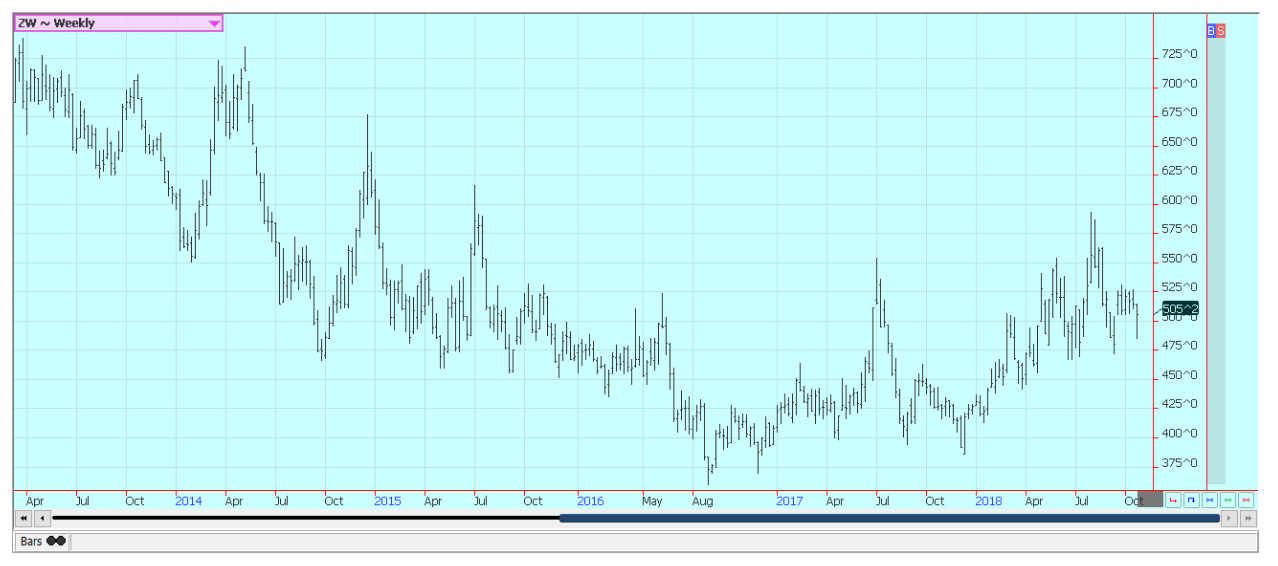
Weekly Chicago Soft Red Winter Wheat Futures © Jack Scoville
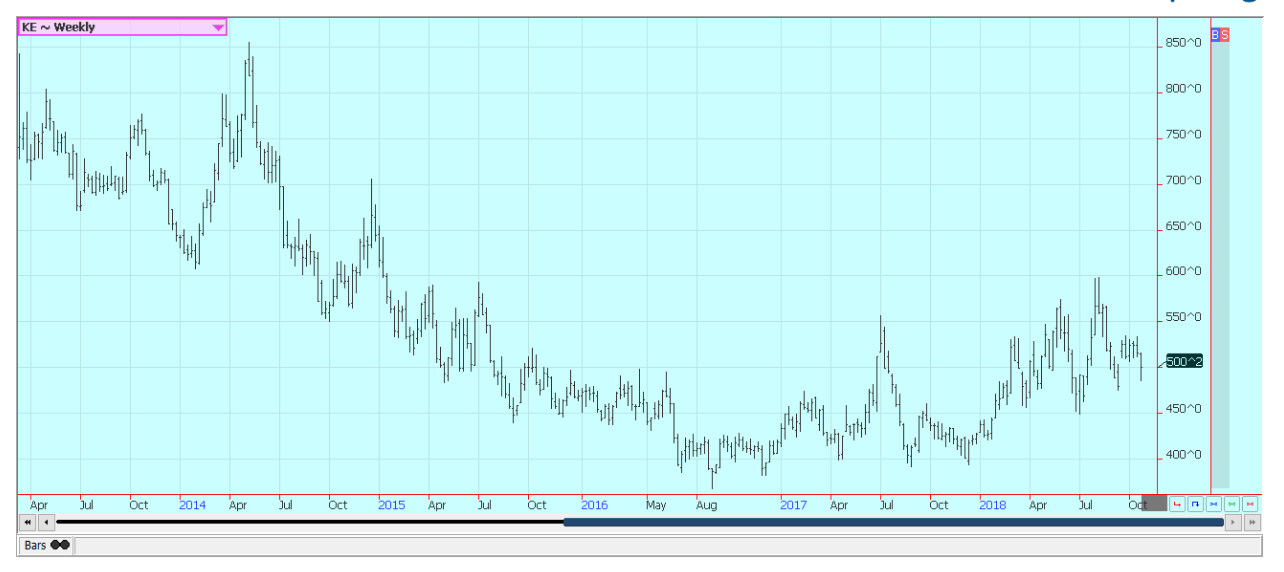
Weekly Chicago Hard Red Winter Wheat Futures © Jack Scoville
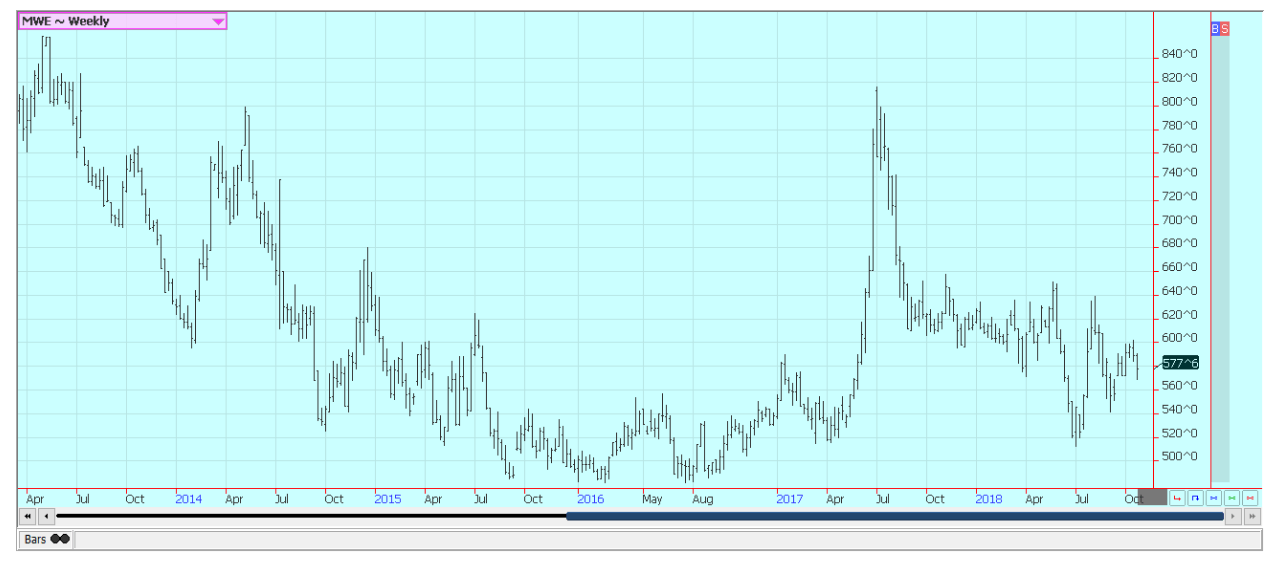
Weekly Minneapolis Hard Red Spring Wheat Futures © Jack Scoville
Corn
Corn was lower for the week despite a solid rally on Friday. Demand was a problem as the weekly export sales report was very bad on Thursday and as ethanol use was lower as well. The charts show that December futures made at least a short-term top. Futures are now in search of new demand. The harvest continues to roll along with at least some work going on in parts of the Midwest.
Rain started to delay harvest progress late last week, and conditions are more variable now with some rain and dry weather mixed together and cool temperatures. Some producers in Iowa said that corn was starting to lose quality due to the harvest delays and reports of diseases and perhaps mold. Other parts of the central Midwest have reported problems and production losses as well. It could be that USDA has overestimated production, but there appears to be a big crop either way. The production losses might not be big enough to materially change price outlooks. Harvest data as reported by producers still suggest that the crop can be another very big one.

Weekly Corn Futures © Jack Scoville

Weekly Oats Futures © Jack Scoville
Soybeans and soybean meal
Soybeans and products were lower last week, and a demand based rally on Friday was not enough to overcome losses made earlier in the week. News that unknown destinations had purchased 200,000 tons of U.S. soybeans for the current crop year and another 60,000 tons for the next crop year helped trigger the Friday rally.
Selling came on weak demand as seen in the export sales report and from news that the Trump administration plans no new trade talks until China puts concrete proposals regarding intellectual property on the table. China is making no moves in that direction, so the market is increasingly resigned to a drawn out trade war that can only continue to hurt U.S. farmers.
Futures are still supported by disease reports as wet soybeans were getting molded and were sprouting in some areas along with some spillover support from the recent USDA reports. The reports indicated less production than expected, but it is still expected to be a huge crop, and the U.S. might have trouble getting it moved to the point where ending stocks are small enough to make a difference in prices.
Current ending stocks estimates are still more than ample, and the weekly export sales report was poor. New sales were strong last week, but cancellations of 600,000 tons of purchases by china kept net sales poor. Brazil is still doing all the business with China despite the wide disparity in prices, and the rest of the world should not be able to make up for the lost business with China for the U.S.
U.S. producers are still trying to harvest, but have been shut down by rains for several days. Showers are likely this week that will keep field work sporadic. Some producers in Iowa and to the west are reporting yield losses and quality losses from the rains that have caused some sprouting and mold to form. Freezing temperatures were seen in northern and western areas and should prove beneficial for harvest progress and the cold could help preserve quality in some cases. Futures appear to have made seasonal lows, but ideas are that upside potential is no more than $9 per bushel right now.

Weekly Chicago Soybeans Futures © Jack Scoville
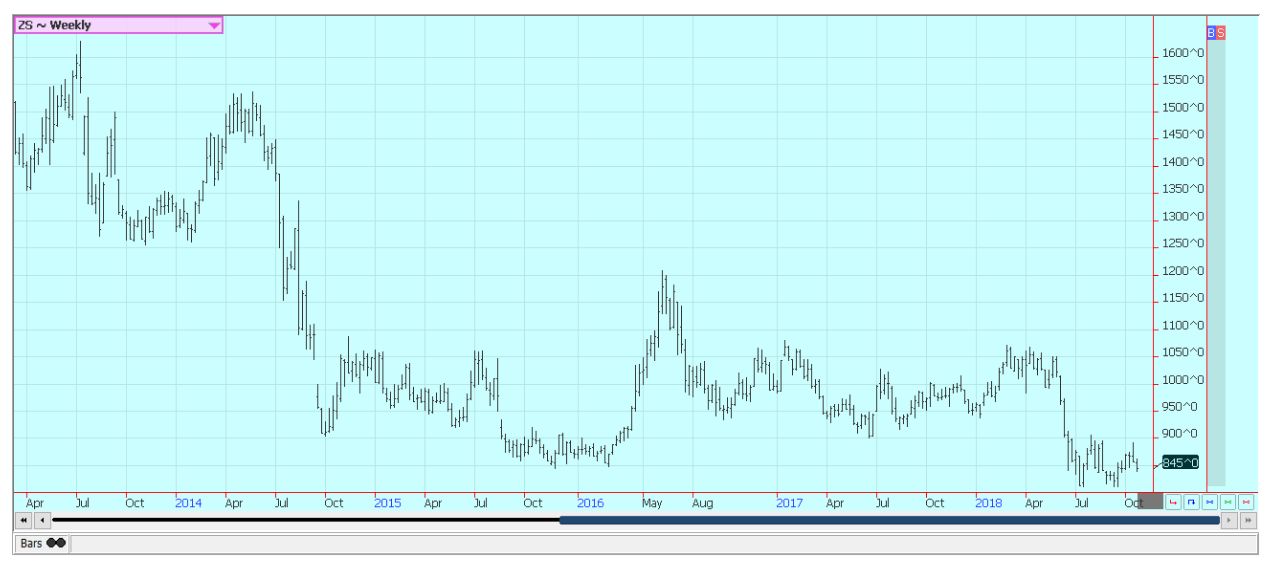
Weekly Chicago Soybean Meal Futures © Jack Scoville
Rice
Rice was lower, but held inside the recent weekly trading ranges. The chart patterns are not well-defined for the short term, but still favor higher prices longer term. The harvest is over in many parts of the Mid South, although there was still a little left to do in Mississippi and Arkansas, and as Texas and Louisiana still were starting to harvest the second crop. Farmers think prices are too cheap and are still concentrating on harvesting in most areas. Others are storing crops and waiting or doing other activities. Storage is said to be difficult to find near the Gulf Coast and in Texas.
Good to excellent yields were reported in Texas and Louisiana, and good to very good yield reports are being made in Mississippi and Arkansas. Cash prices are holding at somewhat weaker levels as mills and elevators fill up. Milling yields have been acceptable to very good. Export demand has been good and the sales report was solid last week. Good export demand is expected to continue.
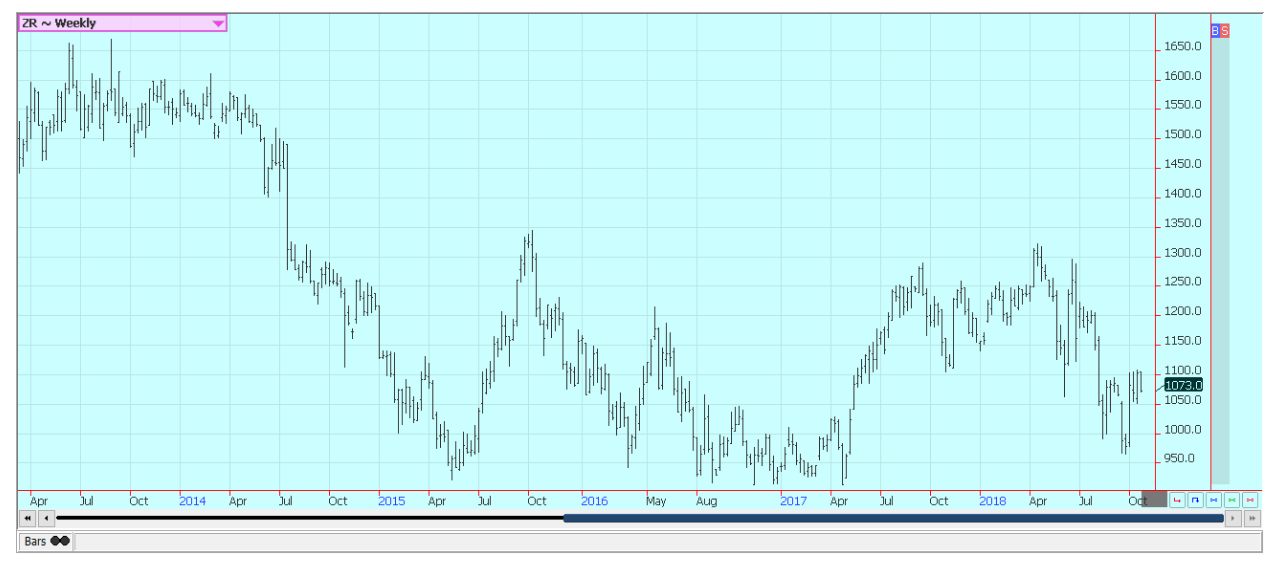
Weekly Chicago Rice Futures © Jack Scoville
Palm oil and vegetable oils
World vegetable oils prices were lower last week, with most in the market worried about finding enough demand to take up the increasing supplies. Palm oil was lower as the demand for export slowed in comparison to the previous month. Ideas are that production is increasing, so the trade will expect an increase in monthly ending stocks figures once the data is released in the next couple of weeks.
Daily and weekly charts show futures in a down trend. The private export surveyors reported a slower pace to exports for the month, and this has been the primary negative for prices. The market is anticipating strong production for the short term as the weather is good for the trees. The weather could hurt production potential down the road. Soybean oil closed. The market is expecting better demand as world petroleum prices have moved higher, but the petroleum markets are now collapsing and causing biofuels markets to move lower. Support is also coming from less offer from South America and on higher Canola prices.
Canola was lower on improved weather and as the harvest started to pick up speed. Farmers have had a tough time getting into the fields due to rains, especially in the west. The weather is now cold, but drier, and farmers are back harvesting again. Progress to date has been significantly behind normal, so the trade will want to hear yield reports again to see if there are new losses. Yield reports so far are said to be below expectations and ideas are that StatsCan has overestimated production potential this year. Yields are expected now to be less, as the harvest moves to completion due to all the rain and snow seen earlier in the harvest season.
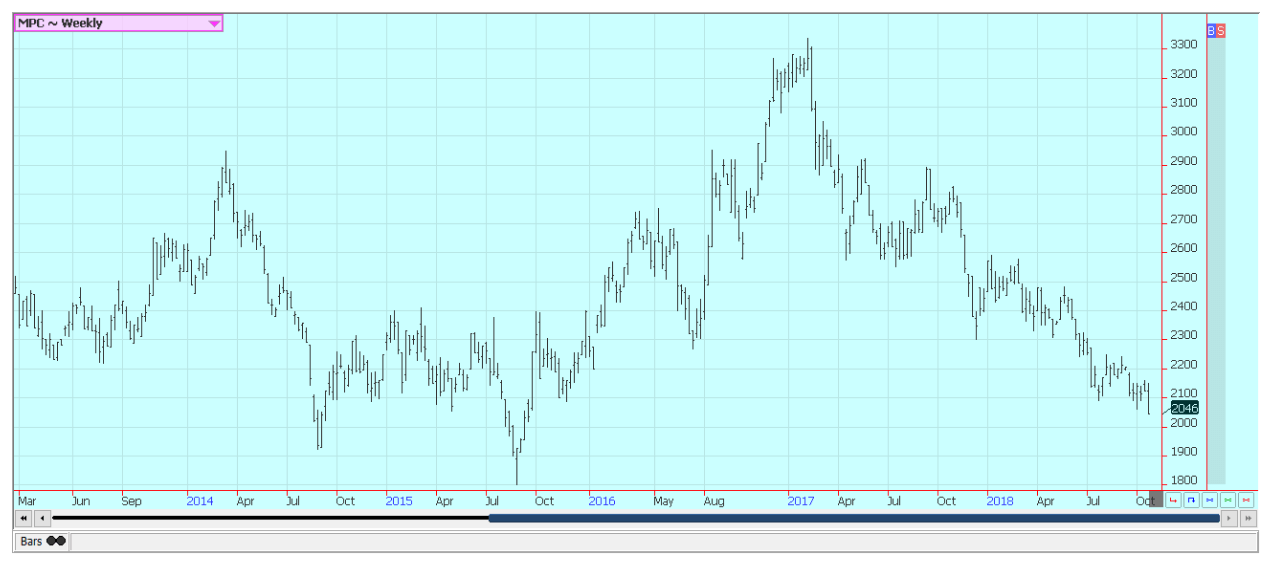
Weekly Malaysian Palm Oil Futures © Jack Scoville
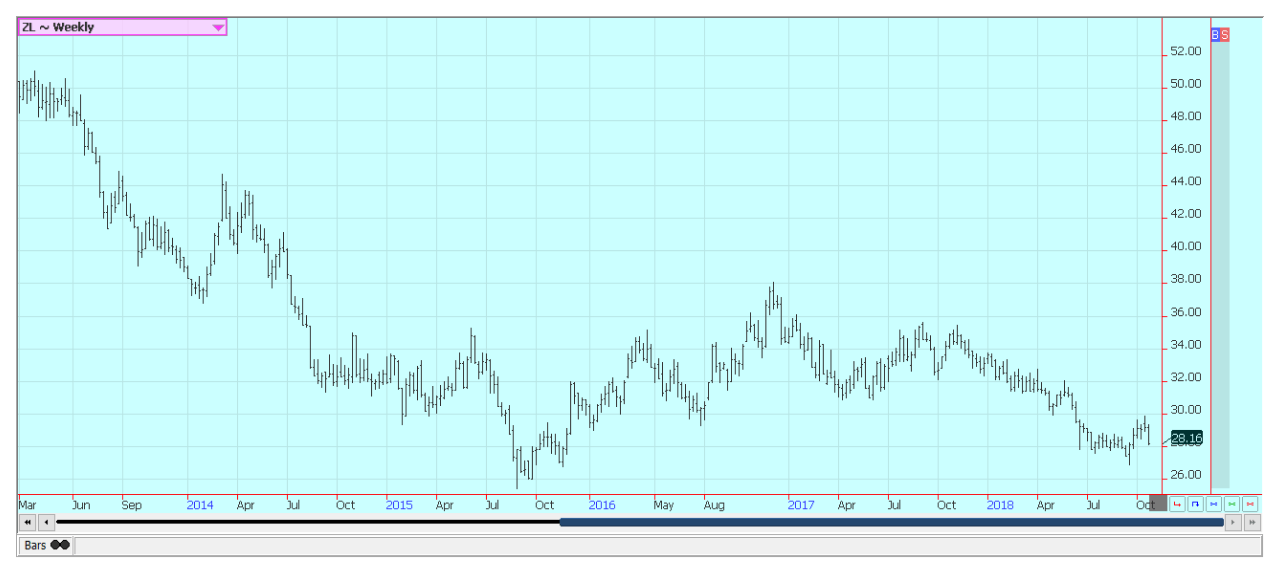
Weekly Chicago Soybean Oil Futures © Jack Scoville

Weekly Canola Futures © Jack Scoville
Cotton
Cotton was slightly higher, but about in mid range for the week after pushing to new highs for the move and giving a strong test of support on the charts. That implies that price moves this week could be significant for the medium term. The weekly export sales report was bad again and the market needs new demand.
Export sales for the last few weeks have been poor and show no real signs of improvement for now. Export demand needs to improve soon for prices to rally significantly this year, but any increase in demand has to come with no purchases from China for a while.
The trade in India remains optimistic that a good crop is coming and that they will not need to import very much Cotton this year. China has been active in India buying and will buy as much as possible there to make up for production losses inside of China.
USDA estimated production down in India and Pakistan due to bad weather during the growing season, so India might not be able to cover all the Chinese demand. U.S. production is reduced after Hurricane Michael ripped into Georgia and brought devastating winds and rain to growing areas and in response to the drought in West Texas seen earlier in the year.

Weekly US Cotton Futures © Jack Scoville
Frozen concentrated orange juice and citrus
FCOJ was a little lower last week. The oranges harvest is underway in Florida under good weather conditions. Chart trends are still mostly down. Overall growing conditions in Florida are good to very good, and there is no storm development in the Atlantic at this time, or at least nothing that would impact the state. Florida producers are seeing good-sized fruit, and work in groves maintenance is active. Irrigation is being used. Packing houses are open to process fruit for the fresh market, and one major processor is open in the state to take packing house eliminations.

Weekly FCOJ Futures © Jack Scoville
Coffee
Futures were lower last week in both markets. Trends are still up in both markets, but futures are now in a correction after posting the best upside moves in a long time. It has been primarily a short covering rally as funds and other speculators have been buying out short positions due mostly to trend changes in the Brazilian Real. The Real has found support as the right wing candidate for president in Brazil won the first round of elections and leads for the second round over the workers party candidate. Initial results of the second round vote suggest that the right wing candidate won, so the Real might hold and build on the recent strength.
Vietnam is getting close to its next harvest, and ideas are that producers there need to sell more of the previous crop to create new storage space. Producers in both countries are not selling much due to perceived low prices. Some problems with too much rain have been noted in Central America. Drier conditions are wanted for harvesting, and mostly dry weather is in the forecast as the calendar turns to November. The rainy season usually starts about now. The rains could eventually impact quality and yields and could make processing and drying of the beans very difficult.
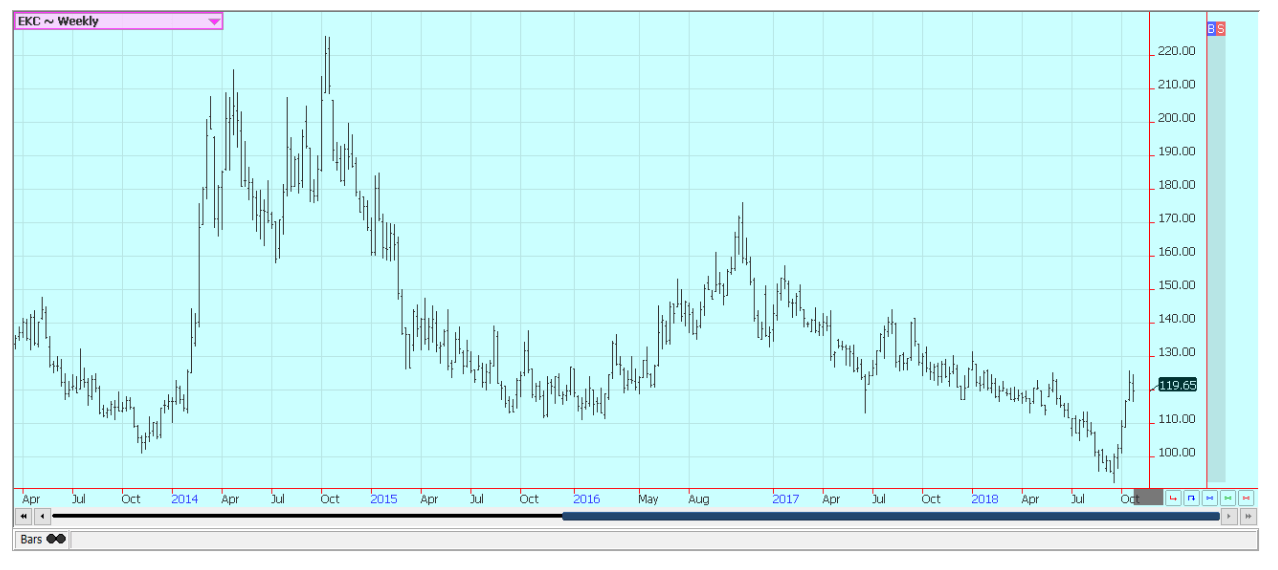
Weekly New York Arabica Coffee Futures © Jack Scoville

Weekly London Robusta Coffee Futures © Jack Scoville
Sugar
New York closed slightly lower last week. London was lower as well. Both markets are showing that medium term lows have been made on the weekly charts. Sugar was supported by reduced selling in Brazil due to the second round presidential elections that were held last weekend and ideas of increasing inflation in the US. The elections created some long liquidation late last week. The Real has been gaining on the US Dollar as a result and this has served to limit export interest in Brazil.
Ideas of big world production are bearish and have been the reason for the selling, but there are now doubts on just how much production will be seen this year in India. Wire reports indicate that pests have invaded Sugarcane fields and are eating and destroying the crop. There is no indication of losses yet, but the implication of the reports is that the losses could be significant.
Northwest India had been experiencing hot and dry weather that could cut yields. Dry conditions continue in Brazil, the EU, and Russia, but conditions are mostly good in Ukraine. Very good conditions are reported in Thailand. Brazil producers are worried about Cane production, and the market still talks about less production there this year. The dry weather in much of Europe and in southern Russia near the Black Sea has hurt Sugarbeets production potential in these areas.
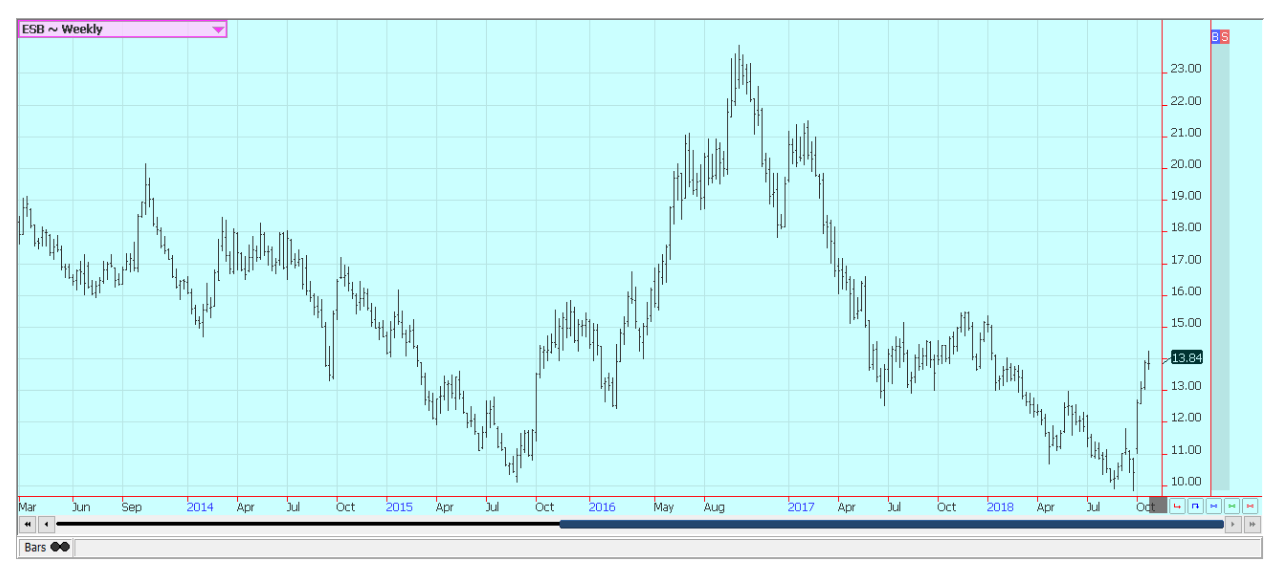
Weekly New York World Raw Sugar Futures © Jack Scoville
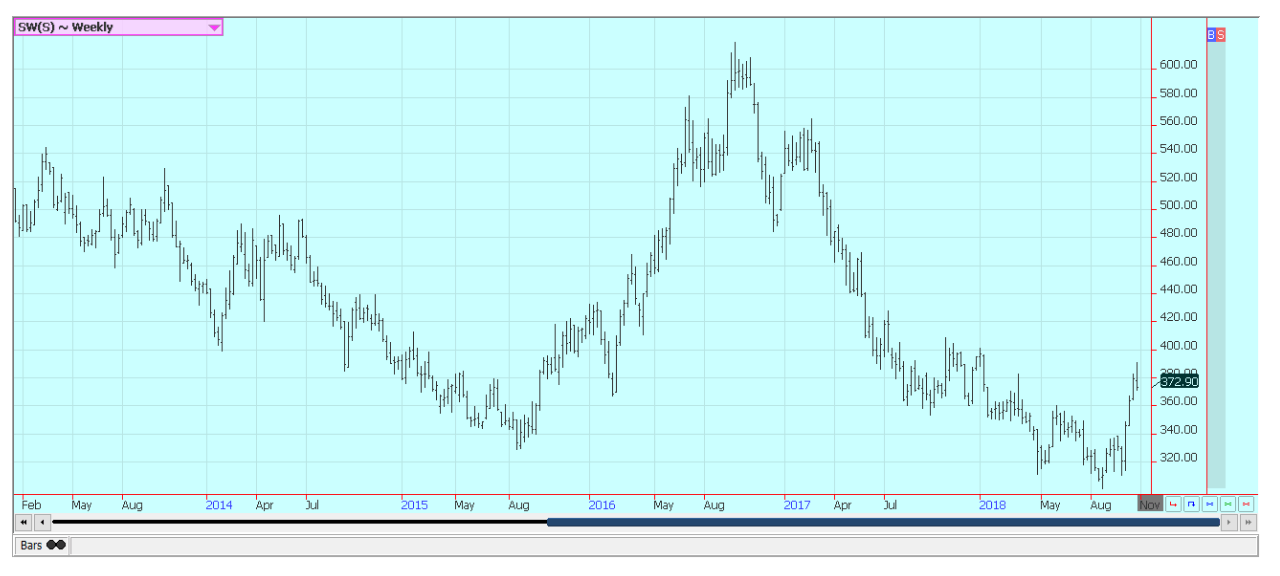
Weekly London White Sugar Futures © Jack Scoville
Cocoa
Futures closed higher in New York and in London as the new main crop harvest comes to market in West Africa. Trends are sideways on the weekly charts for New York, but are now up in London. The recovery has been impressive as it is time for offers from the West Africa harvest to start increasing. The outlook for strong production in the coming year has been enough to keep the prices weak, but there are some disease concerns for West Africa as a lot of humid air has promoted some concerns that Black Pod Disease could spread. In fact, initial harvest reports from Nigeria indicate reduced yields due to too much rain as the main crop was maturing. The main crop harvest is in its earliest stages in some parts of West Africa. Main crop production ideas for Ivory Coast and Ghana are being reduced, with Ivory Coast now estimating its main crop production at 1.985 million tons, down from previous estimates just over 2.0 million tons. Conditions appear good in East Africa and Asia. Demand is said to be improving as offers from the new harvest start to increase.
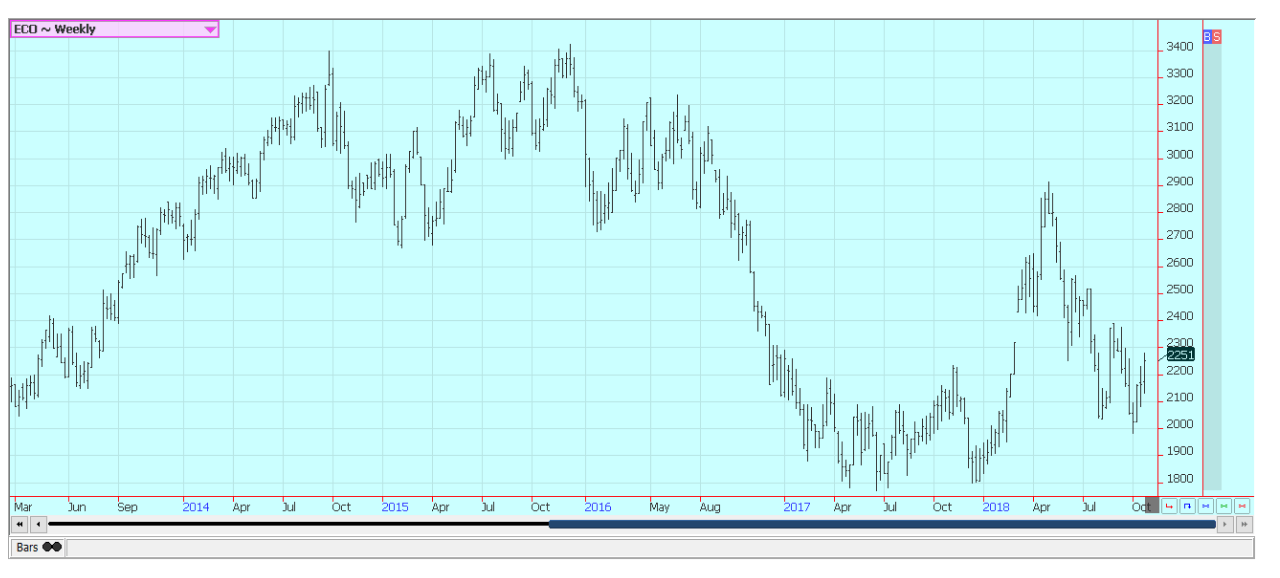
Weekly New York Cocoa Futures © Jack Scoville

Weekly London Cocoa Futures © Jack Scoville
—
DISCLAIMER: This article expresses my own ideas and opinions. Any information I have shared are from sources that I believe to be reliable and accurate. I did not receive any financial compensation for writing this post, nor do I own any shares in any company I’ve mentioned. I encourage any reader to do their own diligent research first before making any investment decisions.

-

 Africa1 week ago
Africa1 week agoCôte d’Ivoire Unveils Ambitious Plan to Triple Oil Output and Double Gas Production by 2030
-

 Business5 days ago
Business5 days agoThe TopRanked.io Weekly Digest: What’s Hot in Affiliate Marketing [NordVPN Affiliate Program Review]
-

 Fintech2 weeks ago
Fintech2 weeks agoBitget Secures Operational License in Georgia, Strengthening Its Eastern Expansion
-

 Cannabis14 hours ago
Cannabis14 hours agoCannabis Company Adopts Dogecoin for Treasury Innovation

























You must be logged in to post a comment Login